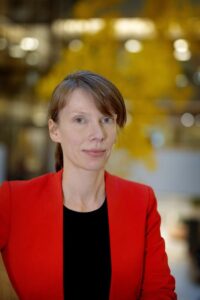Risk of a day without sea ice in the Arctic within few years

This last summer, polar researchers could witness that the sea ice around the North Pole was very thin.
photo: Céline Heuzé
The climate warms fastest in the Arctic. The sea ice there has become so thin that we could already see the first day without sea ice by 2030, according to a new study led by researchers from the University of Gothenburg, Sweden, and University of Colorado in Boulder, USA.

photo: Malin Arnesson
Climate change has weakened the Arctic ice cover. Researchers found that if a series of not-that-unusual weather events were to take place under autumn, winter or spring, there is real risk that the sea ice would completely break down in summer. This is no distant, dystopian scenario. They found that this could already occur before 2030, even as early as 2027.
“The risk of an ice-free Arctic increases as climate change worsens,” says Céline Heuzé, climatologist at the University of Gothenburg and author of that new study in Nature Communications.
No need for an ice breaker
This summer, onboard an expedition to the Arctic Ocean, she and colleagues could indeed witness that the Arctic sea ice is already very thin. Where 20 years ago they would have encountered ice 2m thick or more around the North Pole, this year it was barely 1m on average.
“The sea ice was so thin and “rotten” that it felt like we did not need an ice breaker. It was actually very stressful to work in these conditions; with no sea ice to slow down our progression, we barely had time to collect our data and recover by the time we had already reached the next measurement point,” says Céline Heuzé.
The new study shows that this situation is only going to worsen. The researchers found, using the models from the IPCC, that the risk of an ice-free day in the Arctic within 3 to 6 years is real. The last time this happened was at least 80 000 years ago. When the Arctic Ocean has less than 1 million square kilometers of ice, scientists say the Arctic is ice free. This year the minimum area was 3.67 million square kilometers.
Protective lid
“We used as many simulations as possible and showed that after the Earth reached 1.5 degrees of warming compared to the pre-industrial period, the risk of an ice-free day in the Arctic Ocean becomes non-zero. The risk increases drastically as the climate warms further”, says Alexandra Jahn, Associate Professor at the University of Colorado, also author of the study.
Sea ice acts as a protective lid for the cold Arctic Ocean. When that ice-lid disappears, the ocean absorbs more heat from the atmosphere and warms up, which makes it harder for the sea ice to freeze up comes autumn. Previous projections of Arctic sea ice change have focused on predicting when the ocean will become ice free for a full month, which might happen by the 2030s. Research has shown that this will dramatically change the Arctic ecosystem, but also impact the weather throughout the Northern hemisphere. Researchers have notably previously linked the disappearance of sea ice to extreme weather events such as heat waves, cold spells, storms and droughts.
Chain of events
The authors of this new study found a chain of events that triggers the first ice-free day by late summer in the Arctic. First, the sea ice must be thinner than usual in the previous autumn. Then, a heatwave in winter prevents the sea ice from growing (a heatwave in the Arctic winter means temperature about -20 degree C). Afterwards, the sea ice is so thin and fragile that a strong storm in summer can break the Arctic sea ice.
“All these individual events have already taken place several times in the Arctic, just not in the right order within the same season. The risk for the right sequence only increases with climate change, as our results show. But it is not too late to save the Arctic sea ice – we just need to finally reduce our greenhouse gas emissions!,” says Céline Heuzé.
Wissenschaftliche Ansprechpartner:
Céline Heuzé, Senior Lecturer in climatology at Earth Sciences department of the University of Gothenburg, email: celine.heuze@gu.se
Alexandra Jahn, Associate Professor at the Department of Atmospheric and Oceanic Sciences and Institute of Arctic and Alpine Research, University of Colorado at Boulder, email: alexandra.jahn@colorado.edu
Originalpublikation:
The first ice-free day in the Arctic Ocean could occur before 2030 https://www.nature.com/articles/s41467-024-54508-3
Media Contact
All latest news from the category: Ecology, The Environment and Conservation
This complex theme deals primarily with interactions between organisms and the environmental factors that impact them, but to a greater extent between individual inanimate environmental factors.
innovations-report offers informative reports and articles on topics such as climate protection, landscape conservation, ecological systems, wildlife and nature parks and ecosystem efficiency and balance.
Newest articles

An Endless Loop: How Some Bacteria Evolve Along With the Seasons
The longest natural metagenome time series ever collected, with microbes, reveals a startling evolutionary pattern on repeat. A Microbial “Groundhog Year” in Lake Mendota Like Bill Murray in the movie…

Witness Groundbreaking Research on Achilles Tendon Recovery
Achilles tendon injuries are common but challenging to monitor during recovery due to the limitations of current imaging techniques. Researchers, led by Associate Professor Zeng Nan from the International Graduate…

Why Prevention Is Better Than Cure—A Novel Approach to Infectious Disease Outbreaks
Researchers have come up with a new way to identify more infectious variants of viruses or bacteria that start spreading in humans – including those causing flu, COVID, whooping cough…



